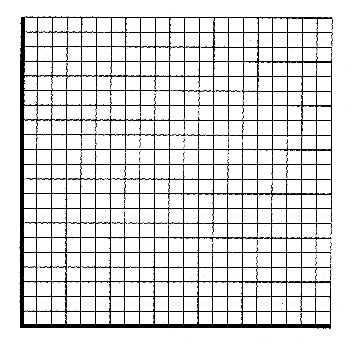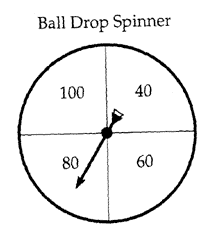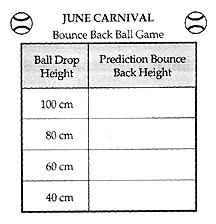|
5th Grade Performance Task
Contributed by: Maryland School Performance Assessment Program (MSPAP)
Description:
Students will be working in teams of four to measure
the rebound heights of a tennis ball dropped from four different
heights. Students wil be investigating with the bouncing balls to
measure changes in the type of energy they possess.
Materials:
- 1 tennis ball
- 1 meter stick
- 2 sheets of scrap paper for recording data
- masking tape (enough to hold the meter stick to the wall)
- 4 calculators
Directions:
Each team member will have a job to do based on a
number: 1, 2, 3, or 4.
Number 1-Tape the meter stick to the wall or any stable
vertical surface with 0 cm at the bottom.
Number 2-Drop the tennis ball from each of the different
heights three times as shown on the chart.
Number 3-Take the measurement of the rebound. Be sure to
use the bottome edge of the ball for your measurements. You should
sit on the floor directly in front of the meter stick and be ready
to watch the ball bounce.
Number 4-Record the data. Make sure other team members copy
the data into their Answer Books after all data is collected.
- Conduct the trials and have the recorder complete the "Ball
Rebound Heights" chart. When you have completed all of the
trials, each of you should copy the data onto your own charts.
|
Starting Height
|
Ball Rebound Heights
|
|
Trial 1
|
Trial 2
|
Trial 3
|
|
100 cm
|
|
|
|
|
80 cm
|
|
|
|
|
60 cm
|
|
|
|
|
40 cm
|
|
|
|
- Remember that one of your classmates had stated that a ball
will not bounce back to the starting height no matter what the
starting position might be. Using evidence from you investigation,
explain whether or not you think your classmate's statement was
true.
- Remember that one of your classmates had stated that a ball
will not bounce back to the starting height no matter what the
starting position might be. Using evidence from your investigation,
explain when or not you think your classmate's statement was you.
- The following chart contains that data collected by a group
of students in another class.
|
Starting Height
|
Ball Rebound Heights
|
|
Trial 1
|
Trial 2
|
Trial 3
|
|
100 cm
|
79 cm
|
81 cm
|
80 cm
|
|
75cm
|
62 cm
|
59 cm
|
59 cm
|
|
50 cm
|
40 cm
|
40 cm
|
40 cm
|
01
|
25 cm
|
21 cm
|
19 cm
|
20 cm
|
STEP A: Use the chart above that contains data collected
by a group of student in another class to calculate and record
the mean height of the rebounds for trials at each height.
100 cm _____________
75 cm _____________
50 cm _____________
25 cm _____________
STEP B: Construct a graph that illustrates the mean
rebound height for each height as calculated in Step A.

In this investigation, you measured that starting height and the
rebound height of the ball. Now let's look at the type of energy
the ball had at different times.
- STEP A: Identify the kind of energy the ball had when
you held the ball at 100 cm.
STEP B: Explain your answer.
STEP C: Identify when the ball has kinetic energy.
- Suppose the rebound height of a ball was 80 cm when its starting
height was 100 cm. Explain what caused the difference in the amount
of energy in the ball.
Think back to the game your class is planning. One student suggested
that you make a spinner of possible drop heights. After using the
spinner to select a drop height, the player will have to predict
the rebound height. If correct, the player will win a prize!
To make the fame more challenging, your class decided to construct
a new spinner with drop heights not used in your investigation.
Turn to your Resource Book and look at the spinner and poster that
could have been used for the game. You have decided on 3 of the
4 choices for the spinner. Unfortunately, you are deadlocked on
the fourth choice. Half of the class wants to put 200 cm on the
spinner and the other half wants to put 20 cm on the spinner. You
don't want to make a mistake because the carnival is next month,
and you have to make the poster and spinner today.


- Write a note to your teacher explaining which number you think
is the better choice. Use your knowledge of science to help you
decide the more reasonable height for the game. Support your choice
with evidence from your investigation.
Dear Teacher,
- Use the graph you constructed in Activity 2, Step B of your
Answer Book to help decided the rebound height measurement you
would predict if the ball was dropped from a height of 120 cm.
STEP A: Write your prediction here._________cm
STEP B: Explain how you arrived at this prediction.
Your class has decided to include a bonus prize for the players
of your game. To get this bonus, the player must calculate the
work done as the ball falls. They will use the drop height they
selected with the spinner when they try to win the bonus.
- STEP A: Meters are units used with length measurements,
newtons are units used with force measurements, and joules are
units used with work measurements. Now that you have this information,
use the rule: Work (joules) = height (meters) times force (newtons)
to calculate the work done when the drop height is 0.5 meters
and force on the ball is 0.6 newtons.
STEP B: How would the amount of work change if the height
were increased?
|




